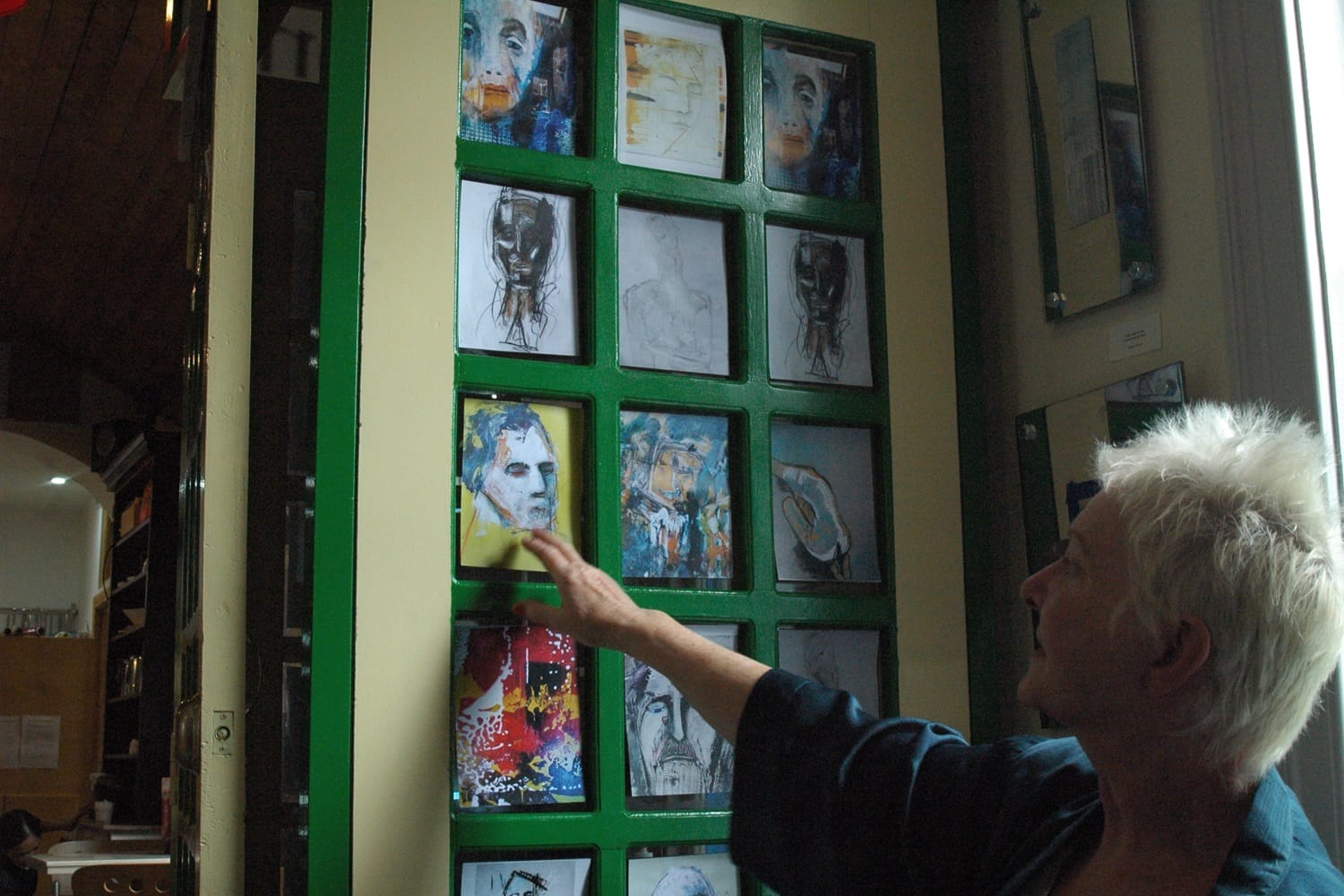What’s the best way to tell area residents about plans for a new asylum shelter nearby?
The government should tell communities directly about plans for new asylum shelters, some activists and politicians say.
The Phoney Gallery, a recent addition to the neighbourhood, gives artists, some active for decades, a chance to stage their first solo shows.

For a long time, the artist Niamh Carroll had a tendency to burn her artwork.
She has a pot-belly stove at her house in Drogheda, she says. “I used to draw on wallpaper because you can just chuck it away.”
At the end of any given week, she would go through all the drawings, she says. “I would have a session where I put them all in the stove, and I played some music and danced around it.”
It was only at her daughter’s request that she stopped destroying the work, she says, laughing.
She is sitting in the corner of the Fair Play Cafe on York Road, at the edge of Ringsend, by the Liffey and Tom Clarke Bridge.
She only gave up the ritual in 2019, at which point, she embarked on four years of intensive work creating portraits, collages and figurative work, she says.
The results are all around her in the small cafe.
On the walls are faces, distorted and almost ghostly, with solemn expressions, and closed eyes. Many of the works are framed between a sheet of glass and a plate of aluminium.
The reflections of the audience and the lighting in a room are important to her work, she says.
Behind her is an old cream and green telephone box with its glass windows covered by 20 different prints, showing smaller versions of Carroll’s paintings, some of which hang elsewhere in the cafe.
Over the door into the phone booth is a sign, which declares that this is The Phoney Gallery, also known as The Smallest Gallery in Ireland.
The booth was set up by her friend, the artist and curator Penny Stuart.
It’s a recent addition to the neighbourhood, giving artists, some active for decades, a chance to stage their first solo shows, Stuart says. “It’s sometimes shocking that an artist like Niamh has never had a solo exhibition, but it’s a huge effort getting your pictures on a wall, and here that’s cut away.”
Stuart, the creator of the Phoney Gallery, stepped inside the booth, which glowed green inside.
She stepped out with one of Carroll’s works, a portrait of a bearded man. His eyes are half closed. His hair is long, and the top of his head is open, like a canyon, with a large X and a pinkish husk floating in the chasm.
It had been painted onto a big ceramic tile using a squeegee, she says. “It’s the face of Our Lord.”
She took a seat by the telephone box, and sipped a bowl of vegetable soup.
The idea for the gallery had come quite suddenly last November, she says. Stuart, who lives in Ringsend, had ducked into the Fair Play Cafe for a coffee.
She noticed the old wooden phone box and thought it might be lovely to stage an exhibition there, she says.
She pitched it to the cafe’s owners. They told her to go for it, she says.


Three weeks later, Stuart launched the gallery, first showing a series of surrealist charcoal illustrations she had created, interpreting different passages from James Joyce’s short story “The Dead”.
“The whole thing was filled with life drawings made into small prints,” she says.
Four women have shown their works since, she says, all artists in their fifties and sixties. Carroll is the most recent, she says.
Stuart only became an artist about five years ago, she says.
She took a painting class in Sandymount, she says. “It was there that I discovered a talent. I just found something that worked.”
She quickly turned to life drawing, primarily with charcoal, and enrolled in classes in Trinity College, she says.
There, she met Carroll and the pair bonded over life drawing, she says. “We’ve connected and are helping each other, which is really fun, because at a time when we could be starting to retire, we’re just revving up.”
Unlike Stuart, Carroll, who grew up in Balbriggan, had always been involved in art, she says. “But I actually couldn’t take it seriously. I had three children, and we lived abroad for 20 years.”
She had been accepted to study fine art at the University of Massachusetts, while the family were living there, she says. “But I couldn’t attend, because my husband’s job was transferred from Boston to Buffalo.”
Going to the life drawing classes in Trinity was her attempt to make up for that lost opportunity, she says.
Neither Carroll nor Stuart had staged a solo exhibition before the phone box, Stuart says.
Trying to get work shown in any galleries is exhaustingly difficult, she says. “It is humiliating when you’re going around with your work in bags, saying, ‘Here’s my work. Can I? Could I?’”
There are funding applications. Curators ask for CVs. It becomes a cycle of not getting exhibited because you haven’t exhibited, she says.
Joe Donnelly, who owns the cafe, didn’t worry about any of that, she says. “He wasn’t saying to show him my pictures. He just thought it was interesting.”
It was a snap decision to create an opportunity for herself and others, she said. Because of her own solo show, her interpretations of James Joyce’s work are now on display in the Joyce Tower Museum in Sandycove.
“You can’t wait around to be picked in the art world,” she says. “You’ve just got to make it happen yourself, and with a bit of life confidence at our age, we’re making it happen.”
Get our latest headlines in one of them, and recommendations for things to do in Dublin in the other.